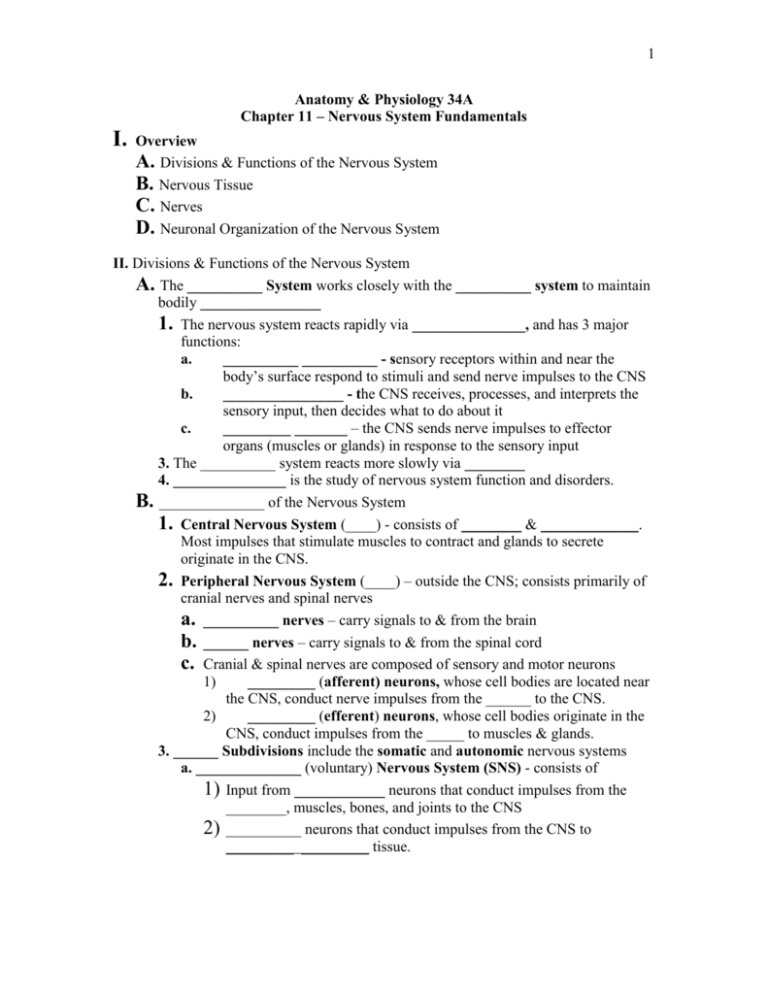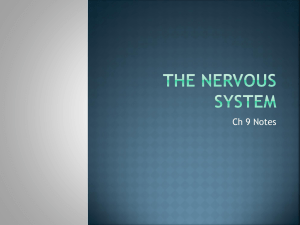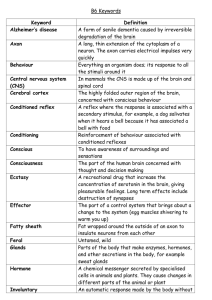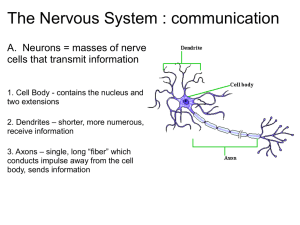Nervous System Fundamentals
advertisement

1 Anatomy & Physiology 34A Chapter 11 – Nervous System Fundamentals I. Overview A. Divisions & Functions of the Nervous System B. Nervous Tissue C. Nerves D. Neuronal Organization of the Nervous System II. Divisions & Functions of the Nervous System A. The __________ System works closely with the __________ system to maintain bodily ________________ 1. The nervous system reacts rapidly via _______________, and has 3 major functions: a. __________ __________ - sensory receptors within and near the body’s surface respond to stimuli and send nerve impulses to the CNS b. ________________ - the CNS receives, processes, and interprets the sensory input, then decides what to do about it c. _________ _______ – the CNS sends nerve impulses to effector organs (muscles or glands) in response to the sensory input 3. The __________ system reacts more slowly via ________ 4. _______________ is the study of nervous system function and disorders. B. ______________ of the Nervous System 1. Central Nervous System (____) - consists of ________ & _____________. Most impulses that stimulate muscles to contract and glands to secrete originate in the CNS. 2. Peripheral Nervous System (____) – outside the CNS; consists primarily of cranial nerves and spinal nerves a. __________ nerves – carry signals to & from the brain b. ______ nerves – carry signals to & from the spinal cord c. Cranial & spinal nerves are composed of sensory and motor neurons 1) _________ (afferent) neurons, whose cell bodies are located near the CNS, conduct nerve impulses from the ______ to the CNS. 2) _________ (efferent) neurons, whose cell bodies originate in the CNS, conduct impulses from the _____ to muscles & glands. 3. ______ Subdivisions include the somatic and autonomic nervous systems a. ______________ (voluntary) Nervous System (SNS) - consists of 1) Input from ____________ neurons that conduct impulses from the ________, muscles, bones, and joints to the CNS 2) __________ neurons that conduct impulses from the CNS to _________ _________ tissue. 2 b. _____________ (involuntary) Nervous System (ANS) - contains 1) Input from _____________ neurons from interoceptors in internal __________ and blood vessels to the CNS 2) General ___________ neurons that convey impulses from the CNS to _______ muscle, ________ muscle, and _________. The ANS is further subdivided into: a) _____________ NS – controls “flight or fight” functions b) _______________ NS – controls “rest and digest” (vegetative) functions III. _______ ___________ and cells: neuroglia & neurons A. ____________ (glia) - Small cells that make up the majority of cells in the CNS; neuroglia support, nourish, and protect neurons. __________ brain tumors are formed by rapidly dividing glial cells. 1. _______ Neuroglia a. ___________ - star-shaped cells with many processes; most abundant glial cell in the CNS; functions: 1) Form structural ____________ between capillaries and neurons of the CNS 2) Take up & release ______ (e.g., K+) to control the neuronal environment 3) Stimulate capillaries to form __________________, establishing the blood-brain barrier c. ______________ - small, phagocytic cells derived from monocytes; _____________ pathogens within the CNS d. _____________ cells – ciliated epithelial cells that line brain ventricles and the spinal cord central canal; they produce and help circulate cerebrospinal fluid (_____). e. ___________________ - similar to astrocytes but with shorter & fewer processes. Functions: 1) Guide ______________ of neurons in the CNS 2) Produce _______________ (lipid & protein) around CNS neuron axons, which insulates axons, increasing speed of nerve impulse conduction. 3) ___________ _____________ involves an autoimmune destruction of this myelin sheath. 2. _____ Neuroglia a. __________ _______- (neurolemmocytes) - flattened cells arranged in series around axons or dendrites; produce the ________ sheath around PNS neuron axons 1) _______________ is the outer nucleated cytoplasmic layer of a Schwann cell; helps to regenerate damaged myelinated PNS neuron ________ or dendrites 3 2) Nodes of ___________ (neurofibral nodes) are gaps between myelin sheath segments on the neuron axon. b. ________ cells (ganglionic gliocytes) - support neurons in _________ (collection of neuron cell bodies in PNS). 3. ___________ – the insulation on myelinated nerve fibers. a. Composition – similar to plasma membranes: 20% __________ and 80% __________ (phospholipids, glycolipids, cholesterol) b. Development – formation begins in the ___th week of fetal development and is complete in late _____________ c. Myelination in the CNS – _______________ processes wrap around a nerve fiber d. Myelination in the PNS – _________ cells wrap many times around a nerve fiber in “jelly roll” fashion. e. Unmyelinated nerve fibers in the PNS lack a _______ sheath, but Schwann cells fold once around the fibers f. Nerve impulse __________ depends on 2 factors 1) Nerve fiber _____________: thicker fibers transmit impulses more ______________ than thinner fibers 2) ___________ nerve fibers conduct impulses ______ (up to 120 m/sec) than unmyelinated fibers (2 m/sec) 4. Schwann cells allow the ________________ of damaged PNS nerve fibers a. The severed end of an ________ and its myelin sheath degenerate b. ______________ remove the debris c. A ______________ _______ is formed by the Schwann cell neurilemma d. The tube guides the growing ______ back to its original destination e. Skeletal muscle cells _____________ when their nerve fiber is severed, but _____________ when the connection is reestablished B. ___________ - nerve cells that conduct nerve impulses at up to ____ mph; lengths range from 1 mm to longest cells in body (about 1 m). Neurons are long lived, have a high metabolic rate, and do not divide. Neuron terms: 1. Nerve _________ - neuron dendrite or axon 2. __________ - bundle of nerve fibers in the PNS; most nerves include both sensory and motor fibers. 3. ____________ - Group of nerve cell bodies in the PNS. 4. ______________ (nuclei) - mass of nerve cell bodies and dendrites inside the CNS. 5. ___________ - Bundle of myelinated nerve fibers in the CNS. Tracts interconnect brain regions as well as regions in the brain to the spinal cord. 6. ________ matter - contains nerve cell bodies, dendrites, and axon terminals or bundles of __________________ axons and neuroglia; forms the Hshaped inner core of spinal cord and covers the cerebrum. 7. ________ matter - aggregation of _______________ neuron processes; surrounds H-shaped inner core of spinal cord and found within the cerebrum. 4 C. Neuron Structure 1. Cell _________ (soma or perikaryon) - contains nucleus, cytoplasm, lysosomes, mitochondria, golgi bodies as well as: a. Lipofuscin - yellowish-brown ___________ remnants b. Nissl bodies - neuronal rough __ for protein synthesis c. ______________ - cytoskeletal intermediate filaments that give the neuron its shape and transport materials 2. ______________ - treelike processes extending from cell body that ___________ impulses from receptors or other neurons and conduct the impulses to the cell body. 3. ________ – single process extending from cell body that ______________ the nerve impulse from the neuron to another neuron, or to an ___________ (muscle or gland). a. Axon ________ (trigger zone) - cone-shaped structure where axon joins cell body b. Axon __________ – infrequent branches off the axon c. Axon ______________ - specialized processes at end of axon collaterals and axons; may end with swollen bumps called ____________________, which contain synaptic vesicles containing neurotransmitters, which influence other neuron, muscle, or gland activities. D. Axons transport materials both ways 1. _____________ transport is the movement of substances (e.g., proteins) from the _______ down the axon 2. _____________ transport moves materials from the ____ terminals to the soma for disposal or recycling E. __________ & Nerve Classification - related to structure (number of cell body processes) and function (sensory/afferent or motor/efferent). ____________classifications include 1. _______polar – usually have several ___________ and one _______; includes most neurons found in brain & spinal cord; ________ neurons are multipolar 2. ____polar - have ___ main dendrite and ___ axon; rare - found in ________, inner ear, and olfactory area of brain; have mostly ____________ functions. 3. ____polar (pseudounipolar) - has _____ process extending from cell body; ______ only. Dendrites located at distal tip of axon; monitors sensory stimuli (touch or pain). 4. _____________ (association neurons) - found only in the _____; not purely sensory or motor; conduct impulses to other neurons; 90% of all neurons in body. 5 5. 6. Neuron & nerve classifications according to ___________ are: a. __________ ____________ - afferent receptors in the _______, bones, muscles, joints, eyes, & ears, deliver impulses (pain, temp., touch, vibration, pressure, position, vision, hearing) ___ the CNS via ________ & some cranial nerves. b. _____________________ - efferent neurons that relay impulses ______ the CNS via motor cranial & spinal nerves and cause the contraction of _________ muscle. c. ___________________ - autonomic afferent neurons that send impulses relaying distention and chemical conditions from ________, blood vessels, tongue, & nasal epithelia to ______ via cranial & spinal nerves. d. _______________ - efferent neurons (autonomic motor fibers) that relay impulses from the CNS via cranial & spinal nerves to smooth & cardiac ________ and _____ A _________ is a collection of neuron fibers held together by loose CT outside the CNS; it consists of the following layers: a. ______neurium CT sheath surrounds each individual nerve fiber b. ______neurium CT surrounds a group of nerve fibers (_____________) c. ______neurium CT surrounds the entire nerve and contains blood vessels & adipose cells d. Most nerves are composed of both motor & sensory fibers, thus are called ________ nerves e. Some ________ nerves consist of only sensory or motor neurons 1) Sensory nerves serve the special _________ (taste, smell, sight, hearing) 2) Motor nerves conduct impulses to _______, causing contraction, or __________, causing secretion.









